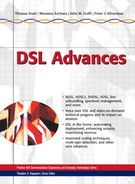Book Description
Cutting-edge xDSL: technology, standards, architecture, regulation, and its application.
The state of the art in DSL technology, standards, and architecture
ADSL, HDSL2, SHDSL, VDSL, line unbundling, spectrum management, and more
Voice over DSL and video-on-demand: technical progress and its impact on services
DSL in the home: automating deployment, enhancing security, maximizing revenue
Improved coding techniques, multi-user detection, and other new advances
Digital Subscriber Lines (DSLs) have transformed millions of ordinary phone lines into broadband arteries that link homes and businesses to the Internet at megabit speeds. DSL Advances brings together the state of the art in DSL technology and architecture for every technical professional and manager. The authors of the classic Understanding Digital Subscriber Line Technology review the key challenges service providers and equipment manufacturers face now, preview tomorrow's most important standards and technical enhancements, and offer new insights into today's regulatory and business environment. Coverage includes:
HDSL2 and SHDSL: The next generation of symmetric DSL technology
Recent developments in ADSL and standards for line unbundling
Spectrum management standards: "traffic cops" for crosstalk management
Voice over DSL and video-on-demand: technical progress that enhances the business case
DSL networked homes: wired/wireless LANs, shared phone and AC wiring?including both centralized splitters and distributed in-line filter premises wiring
Streamlining deployment: CPE auto-configuration and flow-through service provisioning
Security risks and essential safeguards for vendors, service providers, and users
Future directions, including advanced coding techniques and multi-user detection
Table of Contents
- Copyright
- Prentice Hall PTR Communications Engineering and Emerging Technologies Series
- About Prentice Hall Professional Technical Reference
- Preface
- Acknowledgments
- Introduction to DSL
- Review of Transmission Fundamentals for DSLs
- ADSL
- HDSL and Second-Generation HDSL (HDSL2)
- Handshake for the ITU-T Suite of DSL Systems
- Handshake Modulation Method
- Messages and Commands
- G.hs Frame Structure
- Information Field Structure
- Parameter Data Structure
- Transmission Order of the Parameters
- Identification (I) Field
- Standard Information Field
- Nonstandard Information Field
- Message Composition
- G.hs Start-Up/Clear-Down Procedures
- References
- Single-Pair High-Speed Digital Subscriber Line (SHDSL)
- VDSL
- Unbundling and Line Sharing
- Spectral Compatibility of DSL Systems
- Spectrum Management of DSL Systems
- Spectrum Management Background
- The Concept of Spectrum Management
- The Basis Systems
- Spectral Compatibility via Method of Signal Power Limitations (Method A)
- Foundation for Determining Acceptable Levels for Spectral Compatibility
- The Spectrum Management Classes
- Technology-Specific Guidelines
- Analytical Method (Method B)
- References
- Dynamic Spectrum Management (DSM)
- Customer Premises Networking
- DSL CPE Autoconfiguration
- Network Aspects
- DSL and Security
- Voice-over DSL (VoDSL)
- Standards
- Overview of Telco Operations Support Systems
- A Photographic Tour of the Telephone Company Network
- Glossary
